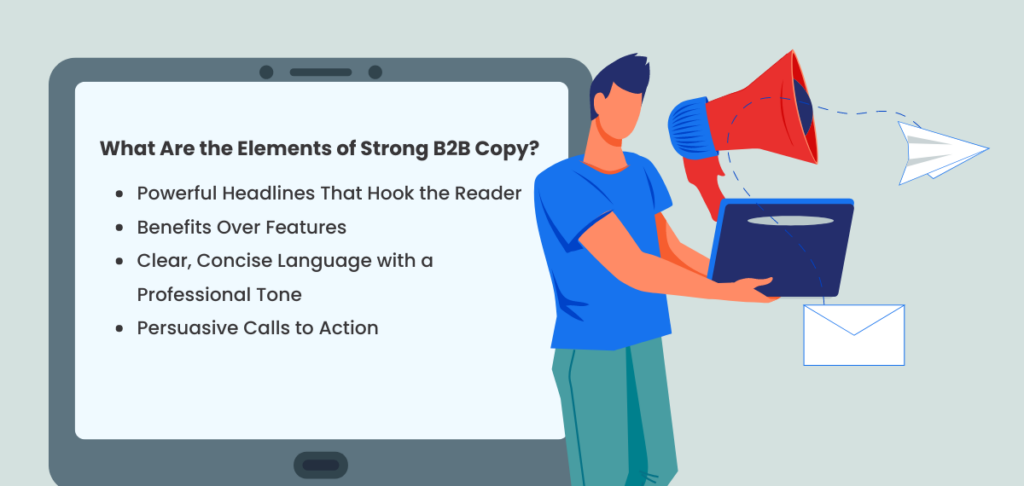B2B copywriting is a type of writing in which every word plays a major role in hooking the attention of other businesses. B2B stands for business-to-business, which means the content is created for other businesses, not the general public, aka B2C (business-to-consumer).
Unlike B2C, where writers use emotion and FOMO to capture the attention of consumers, B2B requires a delicate blend of intellect, understanding, and a sprinkle of charisma. It’s about convincing businesses that your product or service isn’t just nice to have; it’s a must-have for their business.
If you’re looking for more information on B2B copywriting, this quick guide covers everything! I’ll break down B2B content marketing that leads to B2B sales, types of B2B content that work with lead generation and conversion optimization, and more! So, let’s get to it, shall we?
What Is B2B Copywriting?

B2B copywriting is about creating compelling content specifically aimed at other businesses rather than individual consumers. This kind of writing focuses on the needs, challenges, and desires of businesses looking to make smart choices about their products and marketing efforts. The stakes are high, the deals bigger, and the need for precision is an absolute must.
What Is the Purpose of B2B Copywriting?
B2B copywriting helps all businesses communicate the value of specific products and tools that they might need, how they differentiate from competitors, and how they drive action. It’s not just writing; it’s strategic communication—well, good B2B copywriting is, anyway!
Understanding Your B2B Audience: Who’s Listening?
Different businesses—whether brick-and-mortar, home, or online—are all looking for solutions. The manager could be weighing options for a better program to organize employee schedules, or maybe the CEO is looking for a strategic investment in equipment to help the business scale up.
Buyer Personas
Crafting detailed buyer personas will help you tailor the initial message to match the exact needs and pain points of the target audience. For example, if you’re writing about a new piece of software that cuts order fulfillment time in half, the buyer persona for that could be a distributor who faces bottlenecks and delays in shipping products.
Either way, understanding the audience means diving deep into buyer personas, familiarizing yourself with industry jargon, and speaking their language. Just think about it: If you’re selling candy to kids, how would you speak to them? Like you’re speaking to an adult? Or would you get down on their level, use their terminology, and point out all the reasons why they would love your candy?
Okay, that might be a weird example, but you get my point! Knowing the target audience is the first and biggest step in great B2B copywriting.
Industry Language and Terminology
Using the right lingo not only builds credibility but also assures your audience that you truly ‘get’ them. No business owner wants to see a generic “to whom it may concern” type email in their inbox. They want to see that the writer or seller understands their business and their challenges and uses their lingo.
For example, I’m a freelance content writer and a fiction author. I sell my fantasy romance novels to avid readers. But I’m also a control freak who handles all the marketing, designing, formatting, editing, etc. Basically, in a way, I AM a business.
If I get an email or come across an ad from a business selling services or tools to authors, I want to see them using terminology from my “world,” like tropes, KDP, romantasy, and KU.
What Are the Elements of Strong B2B Copy?

Your B2B copy should contain the following elements to stand out from the crowd:
Powerful Headlines That Hook the Reader
The first handshake. Make it firm, confident, and intriguing. In my experience, qualifying them with a question always works great. Something like, “Do you hate crafting weekly email newsletters?” or “Do you want to scale your screen-printing business?”
You could even get really specific and ask something like, “Need better quality shipping boxes for a fraction of the cost you’re paying now?”
Benefits Over Features
Don’t just list what your product does; tell businesses how it solves their problems. That’s what they’re looking for. Most business owners know how to pop online and look for a product they need or want.
But if they come across something that directly solves a problem they’re facing and point out exactly how the product/service can fix it, it’s almost a sure sale.
Clear, Concise Language with a Professional Tone
There should be no fluff. Every word needs to earn its place on the page. In marketing, you only have a few seconds to catch a buyer’s eye and half of that to convince them to buy. Business owners don’t have time for bells and whistles. They want quick answers and solutions.
Persuasive Calls to Action
This is the gentle nudge towards making a decision. Be clear, be enticing, but not pushy or too salesy. It’s a fine line, I know. But it makes all the difference.
B2B Copywriting for Different Formats—What’s the Play?
From the homepage to the email inbox, each platform has its own rules. Let’s go over them.
Website Copy
A website is a business’s digital storefront. As a B2B copywriter, you need to make landing pages inviting and product descriptions clear and compelling to other businesses. Remember, you’re selling to businesses, not regular everyday people.
To get a better idea, go study a website that sells something like hair care products to consumers and compare it to a website that sells something like farm equipment to farmers.
Blog Posts and Articles
Just like regular product marketing, you still need to create shareable content for use on social media and in search engines. Share insights, trends, and solutions. Position yourself as an industry thought leader.
But rather than an article detailing all the pros and cons of a product people don’t actually need, these blog posts and articles should cut straight to the point: This is your business’s problem? Okay, here’s the solution. Bingo, bongo.
Email Marketing Campaigns
Personal, direct, and always adding value. The point is to keep them opening and clicking. Sometimes, businesses don’t realize the issues or challenges they face until they see a product or service that promises to make things easier. That can often take an email or two (or three!)
Just like the great headlines I mentioned earlier, the email subject line would act in the same fashion. Hook them with a qualifying question or a bold statement about the product/service.
White Papers and Case Studies
Think of these as the heavyweight champions of B2B content. Prove a product or service’s worth with data, insights, and real-world success stories straight from other businesses. Share a chart that clearly shows how the item directly improved something for another business. People are far more likely to invest in something if they’re convinced it already works.
What Are Some Tips for Acing B2B Copywriting?
- Emphasizing value proposition: Highlight how the product/service can solve a problem or offer value to a business.
- Using social proof: Testimonials, case studies, proven results, and endorsements for other business owners can help boost credibility majorly.
- SEO considerations: Be sure to optimize everything for search to get your content in front of the right eye. But keep in mind that SEO is a tool, not the master.
- Meta tags and descriptions: A quick description of the product, service, or company. These are your silent salespeople. Make them hardworking and irresistible.
- Keywords: Choose wisely. They’re the breadcrumbs leading the audience to the business.
Ready to Become a B2B Copywriter?
Becoming a B2B copywriter means having strategic creativity and a deep understanding of business dynamics. Just remember, at its core, B2B copywriting is about engaging with businesses on a level that resonates with their goals, challenges, and future plans. You have to think like a business owner in order to sell to them.
I hope my guide helped explain B2B copywriting to you! Let us know if you have any questions or want to check out other types of content writing. I have tons of guides right here on the site!
